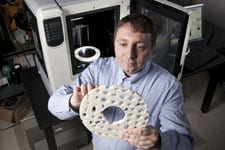
Seven years ago, Duke University engineers demonstrated the first working invisibility cloak in complex laboratory experiments. Now it appears creating a simple cloak has become a lot simpler.
“I would argue that essentially anyone who can spend a couple thousand dollars on a non-industry grade 3-D printer can literally make a plastic cloak overnight,” said Yaroslav Urzhumov, assistant research professor in electrical and computer engineering at Duke’s Pratt School of Engineering.
Three-dimensional printing, technically known as stereolithographic fabrication, has become increasingly popular, not only among industry, but for personal use. It involves a moving nozzle guided by a computer program laying down successive thin layers of a material — usually a polymer plastic — until a three-dimensional object is produced.
Urzhumov said that producing a cloak in this fashion is inexpensive and easy. He and his team made a small one at Duke which looks like a Frisbee™ disc made out of Swiss cheese. Algorithms determined the location, size and shape of the holes to deflect microwave beams. The fabrication process takes from three to seven hours.
The results of Urzhumov’s experiments were published online in the journal Optics Letters, and the team’s research was supported by the U.S. Army Research Office through a Multidisciplinary University Research Initiative grant.
Just like the 2006 cloak, the newer version deflects microwave beams, but researchers feel confident that in the not-so-distant future, the cloak can work for higher wavelengths, including visible light.
“We believe this approach is a way towards optical cloaking, including visible and infrared,” Urzhumov said. “And nanotechnology is available to make these cloaks from transparent polymers or glass. The properties of transparent polymers and glasses are not that different from what we have in our polymer at microwave frequencies.”
The disk-like cloak has an open area in its center where the researchers placed an opaque object. When microwave beams were aimed at the object through the side of the disk, the cloak made it appear that the object was not there.
“The design of the cloak eliminates the ‘shadow’ that would be cast, and suppresses the scattering from the object that would be expected,” said Urzhumov. “In effect, the bright, highly reflective object, like a metal cylinder, is made invisible. The microwaves are carefully guided by a thin dielectric shell and then re-radiated back into free space on the shadow side of the cloak.”
Urzhumov said that theoretically, the technique can be used to create much larger devices.
The Latest Bing News on:
Invisibility cloak
- MIT Technology Reviewon April 22, 2024 at 4:59 pm
Precancerous colon cells turn on a gene that helps them evade the immune system until they develop into tumors. One of the immune system’s roles is to detect and kill cells that have acquired ...
- Realization of an ideal omnidirectional invisibility cloak in free spaceon April 22, 2024 at 10:00 am
A team led by Prof. Dexin Ye and Prof. Hongsheng Chen from Zhejiang University, and Prof. Yu Luo from Nanyang Technological University conducted research on the practical implementation of ...
- Startup Selling Invisibility Shieldson April 21, 2024 at 5:00 pm
The largest version is a whopping six feet tall, large enough to "hide multiple people standing side by side," per the company's Kickstarter page — and it just might be as close to a Harry ...
- Realization of an ideal omnidirectional cloak in free spaceon April 19, 2024 at 9:49 am
The past decade has witnessed the rapid development of transformation optics, through which various novel optical devices such as invisibility cloaks, electromagnetic illusion devices and ...
- Helping Lone Workers Shed the Invisibility Cloakon April 15, 2024 at 5:00 pm
Many people might wish they had their own invisibility cloaks from time to time. But there is one group of people who would like to get rid of theirs. They are lone workers, whose jobs take them ...
- Scientists solved the 70-year-old mystery of an insect's invisibility coat that can manipulate lighton April 15, 2024 at 10:12 am
We tend to think of invisibility cloaks as science fiction. But one group of scientists has taken a big step toward making them a reality. For the first time, scientists at Pennsylvania State ...
- Scientists solved the 70-year-old mystery of an insect's invisibility coat that can manipulate lighton April 14, 2024 at 5:00 pm
They hope their brochosomes will one day be used for invisible cloaking devices and other technologies. We tend to think of invisibility cloaks as science fiction. But one group of scientists has ...
- Backyard insect inspires invisibility devices, next gen techon March 18, 2024 at 6:24 am
Perhaps someday people could develop a thermal invisibility cloak based on the tricks used by leafhoppers. Our work shows how understanding nature can help us develop modern technologies.” ...
The Latest Google Headlines on:
Invisibility cloak
[google_news title=”” keyword=”invisibility cloak” num_posts=”10″ blurb_length=”0″ show_thumb=”left”]
The Latest Bing News on:
Optical cloaking
- One of Our Favorite Superpowers Is Now a Real Possibility: Invisibility Shield 2.0on May 1, 2024 at 2:54 am
That's because a group of engineers and scientists, or as I like to call them, optical illusionists, has been working on what you see for over the past four years. Now, invisibility or cloaking ...
- The Best Optical Gaming Keyboards in 2024on April 28, 2024 at 1:36 am
The best optical gaming keyboards are quickly becoming a popular choice among gamers, thanks to fewer moving parts to go wrong, and a shorter actuation distance (a fancy way of saying you can type ...
- The Best Compact Binoculars of 2024, Tested and Reviewedon April 24, 2024 at 4:34 am
A compact 8×32 binocular, with good glass and glare-cutting coatings, has nearly the same optical horsepower of older 10x42s. Also, their smaller frame weighs less, boasts a wider field of view, tucks ...
- Realization of an ideal omnidirectional invisibility cloak in free spaceon April 22, 2024 at 10:00 am
A team led by Prof. Dexin Ye and Prof. Hongsheng Chen from Zhejiang University, and Prof. Yu Luo from Nanyang Technological University conducted research on the practical implementation of ...
- Realization of an ideal omnidirectional cloak in free spaceon April 19, 2024 at 9:49 am
and the EM waves propagating in the optical direction have an infinite phase velocity. This material is used to enable the EM wave to bypass a cloaking region with omnidirectional impedance ...
- Ex-official assures right-wingers: Trump just "cloaking" his actual "extreme" plans to get voteson April 17, 2024 at 6:31 am
“I actually think there’s wisdom in cloaking some of your power levels and maybe some of the things that you’re trying to do, and then once you secure power, and you have it, you govern in a ...
- Optical Illusion challenge: What you see first reveals if you are a practical or romantic individualon March 29, 2024 at 5:27 am
Optical illusions often have the power to reveal playful traits about your personality. This is a small journey filled with excitement and at times relatable to one’s personality with relevant ...
- A Real Life Invisibility Shield for Privacy in Public Placeson March 28, 2024 at 12:58 pm
The aptly-named Invisibility Shield Company has debuted the second generation of their easily transported, free-standing optical cloaking shield that allows people to hide in plain sight.
- You can now buy a real-life invisibility shieldon March 27, 2024 at 6:32 am
London-based Invisibility Shield Co has spent years designing the latest versions of it ‘optical cloaking technology’, which can hide people and objects completely from view in broad daylight.
- Backyard insect inspires invisibility devices, next gen techon March 18, 2024 at 6:24 am
This could allow the development of bioinspired optical materials with possible applications ranging from invisible cloaking devices to coatings to more efficiently harvest solar energy ...
The Latest Google Headlines on:
Optical cloaking
[google_news title=”” keyword=”optical cloaking” num_posts=”10″ blurb_length=”0″ show_thumb=”left”]










